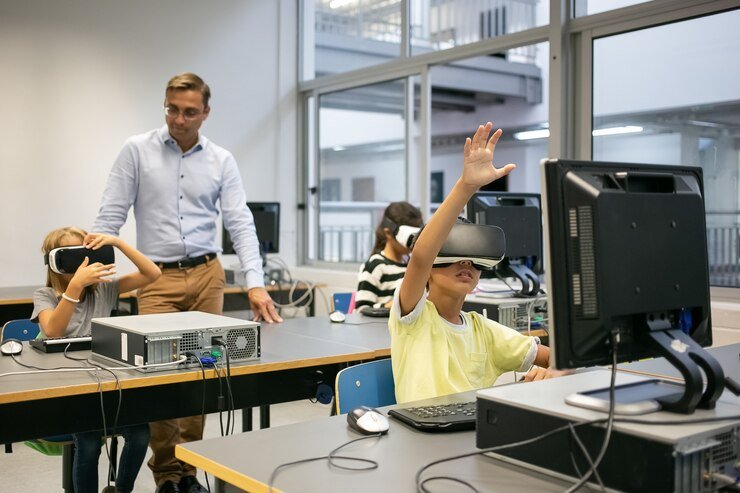
Introduction to the Rapid Advancements in Education Technology
In an era where technology is reshaping every facet of our lives, education is no exception. From interactive lessons to AI-driven personalized learning, the landscape of education is undergoing a seismic shift. This transformation is not just about adopting new tools but about redefining the very process of teaching and learning.
For educators, staying ahead of these technological advancements is crucial. This blog post aims to explore the impact of technology on education, the challenges and opportunities it brings, and how educators can adapt and thrive in this digital age.
The Impact of Technology on the Teaching and Learning Process
Engaging Students Like Never Before
Technology has revolutionized the way educators engage with students. Interactive whiteboards, educational apps, and virtual reality (VR) experiences have replaced traditional chalk-and-talk methods. These tools make learning more engaging and interactive, catering to diverse learning styles and keeping students motivated.
Personalized Learning Paths
One of the most significant impacts of technology is the ability to provide personalized learning experiences. Through AI-driven platforms, educators can tailor lessons to meet the individual needs of each student. This ensures that every learner progresses at their own pace, making education more inclusive and effective.
Data-Driven Insights
With the integration of technology, educators now have access to a wealth of data on student performance. This data-driven approach allows for more informed decision-making, helping teachers identify areas where students may need additional support and adjust their teaching strategies accordingly.
Challenges and Opportunities for Educators in Integrating Technology
Navigating the Learning Curve
While technology offers numerous benefits, integrating it into the classroom comes with its own set of challenges. Educators often face a steep learning curve in mastering new tools and platforms. Continuous professional development and training are essential to overcome this hurdle and make the most of technological advancements.
Ensuring Equity and Access
Another significant challenge is ensuring that all students have equal access to technology. Socioeconomic disparities can create a digital divide, where some students may lack the necessary devices or internet connectivity. Schools and educators must work towards bridging this gap to provide equitable learning opportunities for all.
Balancing Screen Time
While technology enhances learning, excessive screen time can have adverse effects on students’ health and well-being. Educators need to strike a balance between digital and traditional teaching methods, ensuring that technology complements rather than dominates the learning experience.
Case Studies and Examples of Successful Technology Integration in Classrooms
Flipped Classrooms
The flipped classroom model is a prime example of successful technology integration. In this approach, students watch pre-recorded lectures at home and engage in interactive activities during class time. This model promotes active learning and allows educators to spend more time addressing students’ individual needs.
Gamification in Education
Gamification has proven to be an effective strategy in making learning fun and engaging. By incorporating game elements such as points, badges, and leaderboards, educators can motivate students and foster a competitive yet collaborative learning environment. A notable example is the use of platforms like Kahoot! in classrooms worldwide.
Virtual Field Trips
Virtual field trips offer students the opportunity to explore places they might never visit in person. Through VR headsets and online platforms, educators can take students on immersive journeys to historical sites, museums, and even outer space. This not only enriches the learning experience but also broadens students’ horizons.
Tips and Best Practices for Educators to Adapt to the Changing Landscape of Education Technology
Continuous Professional Development
To keep pace with technological advancements, educators must prioritize continuous professional development. Attending workshops, webinars, and online courses can help teachers stay updated on the latest tools and best practices. Engaging in professional learning communities also provides valuable support and resources.
Collaborate and Share Knowledge
Collaboration among educators is essential in navigating the challenges of technology integration. Sharing experiences, strategies, and resources can foster a culture of collective growth. Online forums, social media groups, and school-based professional learning communities are excellent platforms for collaboration.
Start Small and Scale Up
When integrating new technology, it’s best to start small and gradually scale up. Begin with a few tools that align with your teaching objectives and slowly incorporate more as you become comfortable. This approach minimizes overwhelm and allows for a smoother transition.
Future Predictions for the Role of Technology in Education and How Educators Can Prepare for It
The Rise of Artificial Intelligence
Artificial intelligence is set to play a more prominent role in education. AI-powered tutoring systems, predictive analytics, and automated grading are just a few examples of how AI can enhance the teaching and learning experience. Educators should familiarize themselves with AI applications and explore ways to incorporate them into their classrooms.
The Growth of Online and Blended Learning
The COVID-19 pandemic has accelerated the adoption of online and blended learning models. This trend is likely to continue, with more schools incorporating online components into their curricula. Educators must adapt to these new formats and develop strategies to engage students in virtual environments.
Focus on Digital Literacy
As technology becomes an integral part of education, digital literacy will be crucial for both educators and students. Teaching digital literacy skills, such as online research, digital communication, and cybersecurity, will prepare students for the demands of the 21st-century workforce.
Conclusion
In conclusion, the integration of technology in education offers immense potential to transform the teaching and learning process. While there are challenges, the opportunities for innovation and improved outcomes far outweigh them. Educators who embrace continuous learning and adaptation will be well-equipped to thrive in the digital age.